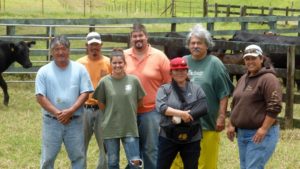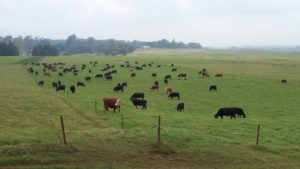Big Island Cows Breed Success
Mealani Research Station on Hawaiʻi Island, an agricultural experiment station of the University of Hawai‘i College of Tropical Agriculture and Human Resources, is the “perfect living lab for researching cattle production in the tropics and subtropics,” said Kyle Caires, assistant extension agent in the college’s Department of Human Nutrition, Food and Animal Sciences.
In this field, genetics is key and the station’s breeding program is thriving.
Mealani’s Angus bulls were recently ranked among the top 10%, with four animals in the top 1% in the Zoetis HD 50K, the gold standard for genomic prediction. This elite genetic testing only compares the top 5,000 Angus cattle in the country.
“This level of quality is unheard of in beef herds across the nation,” said Cooperative Extension Agent Michael DuPonte.
Breed local
Genetic traits that the college is researching include some that can help producers to match cattle qualities with the areas in which they’ll be raised, including fitness for the amount of rain and sun, the temperature and humidity, and the types of forage growing there. In areas with high humidity, cows with smooth hair do better than those with thick, coarse coats. Cattle with high growth potential need to be matched with areas with ample nutritious forage material, while those that will grow to be smaller can graze in places with lower-quality feedstuffs.
Such genetic matching is particularly important in Hawaiʻi because of the islands’ diverse and distinct microclimates—even individual ranchers ideally may have a “makai herd” and a “mauka herd” with different varieties, said Caires.
Also, because the potential rangelands here are relatively small, it’s crucial to maximize efficiency to compete in the market.
Different options
Mealani uses two modes of breeding, artificial insemination (AI) and “natural service.” For AI, the semen is shipped frozen to the station, where it is used to introduce desired genetic traits to the herd. Mealani typically holds AI School once a year, when UH Mānoa and UH Hilo students and local ranchers come to gain the physical prowess that complements the cutting-edge research.
Technique is involved in the natural service breeding too. Before being released into the field with the cows, the specially chosen bulls are fitted with cone-shaped metal muzzles daubed with paint. When mating, the bulls touch their noses to the cows’ backs, and the paint on the muzzles marks them, keeping track of the cows that have been serviced.
The painstaking breeding operation is paying off. More and more local ranchers are able to make use of the station’s research for their operations, including buying the prime-bred bulls for their own herds. The station also plans to contract with a stud operation in the future, to make semen from its bulls available to other producers for AI, DuPonte said.


















